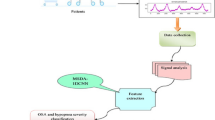Abstract
Sleep disorders can cause many inconveniences, such as mental fatigue, poor concentration, emotional instability, memory loss, reduced work efficiency, and increased accident rates. Among them, obstructive sleep apnea is a common sleep disorder characterized by repeated apnea and snoring during nighttime, affecting sleep quality, daily life, and work. Therefore, predicting obstructive sleep apnea events can help people better identify and treat sleep disorders and improve quality of life and work efficiency. To enhance the performance of predicting obstructive apnea, we use the MIT-BIH polysomnographic database in this article. We used deep learning methods, specifically transfer learning, with the AlexNet framework to predict the outcome of OSA events. The results show that the best optimization algorithm is SGDM. The accuracy rate is 86.63%, the sensitivity is 92.20%, the precision is 90.55%, and the AUC is 91.95%. This study demonstrates the strong potential of using artificial intelligence techniques, specifically deep learning and transfer learning, to predict OSA events from ECG signals, which could provide valuable information for diagnosing and treating sleep disorders.
Access this chapter
Tax calculation will be finalised at checkout
Purchases are for personal use only
Similar content being viewed by others
References
How to Diagnose & Treat the 5 Most Common Sleep Disorders. American Association of Sleep Technologists. https://www.aastweb.org/blog/how-to-diagnose-treat-the-5-most-common-sleep-disorders. Accessed 25 Jan 2023
Regional Office for Europe, European Centre for Environment and Health Bonn Office, World Health Organization. WHO Technical Meeting on Sleep and Health: Bonn Germany, 14–17 (2004). https://apps.who.int/iris/handle/10665/349782. Accessed 26 Jan 2023
Goldstein, C., Berry, R., et al.: Artificial intelligence in sleep medicine: An American Academy of sleep medicine position statement. J. Clin. Sleep Med. 16(4), 605–607 (2020). https://doi.org/10.5664/jcsm.8288
Hepsiba, D., Vijay Anand, L., Princy, J.: Deep learning for sleep disorders: A review. In: Proceedings of 2021 Seventh International Conference on Bio Signals, Images, and Instrumentation (ICBSII) (2021). https://doi.org/10.1109/ICBSII51839.2021.9445159
Malhotra, A., White, D.: Obstructive sleep apnea. The Lancet 360(9328), 237–254 (2002). https://doi.org/10.1016/S0140-6736(02)09464-3
Kribbs, B., Pack, I., Kline, R., et al.: Objective measurement of patterns of nasal CPAP use by patients with obstructive sleep apnea. ATS Journals 147(4), 887–895 (2012). https://doi.org/10.1164/ajrccm/147.4.887
Epstein, L., et al.: Adult obstructive sleep apnea task force of the American Academy of sleep medicine. Clinical Guideline for the Evaluation, Management and Long-Term Care of Obstructive Sleep Apnea in Adults. J. Clin. Sleep Med. 5(3), 263–276 (2000). https://doi.org/10.5664/jcsm.27497
Moore, K.: Site-specific versus diffuse treatment presenting severity of obstructive sleep apnea. Sleep Breath. 4(04), 145–146 (2000). https://doi.org/10.1055/s-2000-19520
Ichimaru, Y., Moody, B.: Development of the polysomnographic database on CD-ROM. Psychiat. Clin. Neurosci. 53(2), 175–177 (1999). https://doi.org/10.1046/j.1440-1819.1999.00527
Esteva, A., Kuprel, B., Novoa, A., et al.: Dermatologist-level classification of skin cancer with deep neural networks. Nature 542(7639), 115–118 (2017). https://doi.org/10.1038/nature21056
Rajpurkar, P., et al.: Chexnet: Radiologist-level Pneumonia detection on chest X-rays with deep learning. arXiv preprint arXiv:1711.05225 (2017). https://doi.org/10.48550/arXiv.1711.05225
Bejnordi, E., et al.: Diagnostic assessment of deep learning algorithms for detection of lymph node metastases in women with breast cancer. JAMA 318(22), 2199–2210 (2017). https://doi.org/10.1001/jama.2017.14585
Taghizadegan, Y., Dabanloo, N.J., Maghooli, K., Sheikhani, A.: Obstructive sleep apnea event prediction using recurrence plots and convolutional neural networks (RP-CNNs) from polysomnographic signals. Biomed. Signal Process. Control 69, 102928 (2021). https://doi.org/10.1016/j.bspc.2021.102928
Abd Almisreb, A., Jamil, N., Din, M.: Utilizing AlexNet deep transfer learning for ear recognition. In: Proceedings of 2018 Fourth International Conference on Information Retrieval and Knowledge Management (CAMP), pp. 1–5. IEEE (2018). https://doi.org/10.1109/INFRKM.2018.8464769
Diederik, K., Jimmy, B.: Adam: A method for stochastic optimization. arXiv preprint. arXiv:1412.6980 (2014)
Rumelhart, E., Hinton, E., Williams, J.: Learning representations by Back-Propagating errors. Nature 323(6088), 533–536 (1986). https://doi.org/10.1038/323533a0
Hinton, G., Srivastava, N., Swersky, K.: Neural networks for machine learning lecture 6a overview of Mini-Batch Gradient Descent. Cited on 14(8), 2 (2012)
Mallat, S.: A Wavelet Tour of Signal Processing. Academic Press (1999)
Krizhevsky, A., Sutskever, I., Hinton, E.: ImageNet classification with deep convolutional neural networks. Commun. ACM 60(6), 84–90 (2017). https://doi.org/10.1145/3065386
Sokolova, M., Lapalme, G.: A systematic analysis of performance measures for classification tasks. Inf. Process. Manag. 45(4), 427–437 (2009). https://doi.org/10.1016/j.ipm.2009.03.002
Author information
Authors and Affiliations
Corresponding author
Editor information
Editors and Affiliations
Rights and permissions
Copyright information
© 2023 IFIP International Federation for Information Processing
About this paper
Cite this paper
Peng, CC., Kou, CY. (2023). Sleep Disorder Classification Using Convolutional Neural Networks. In: Maglogiannis, I., Iliadis, L., MacIntyre, J., Dominguez, M. (eds) Artificial Intelligence Applications and Innovations. AIAI 2023. IFIP Advances in Information and Communication Technology, vol 675. Springer, Cham. https://doi.org/10.1007/978-3-031-34111-3_45
Download citation
DOI: https://doi.org/10.1007/978-3-031-34111-3_45
Published:
Publisher Name: Springer, Cham
Print ISBN: 978-3-031-34110-6
Online ISBN: 978-3-031-34111-3
eBook Packages: Computer ScienceComputer Science (R0)





